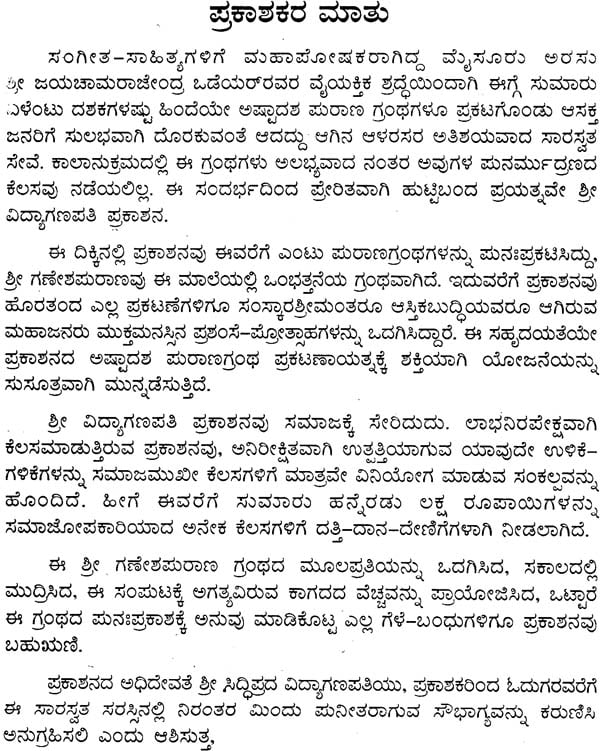
Vishnu Purana In Kannada Pdf To Word
Vishnu Affiliation, (),,, Tridev Abode, ॐ नमो नारायणाया (Om Namo Narayanaya) ॐ नमो भगवते वासुदेवाय () Weapon discus () and mace ( ),, Festivals,,, Narasimha Jayanti,,,,,,,, Personal information Consorts -, Children, Sundaravalli, Amritavalli, Siblings alias, (elder brother), (younger brother) Vishnu (; Sanskrit pronunciation:;: विष्णु,: Viṣṇu) is one of the of, and the Supreme Being or absolute truth in its tradition. Vishnu is the 'preserver' in the Hindu triad () that includes.
In, Vishnu is identical to the formless metaphysical concept called, the supreme, the, who takes various as 'the preserver, protector' whenever the world is threatened with evil, chaos, and destructive forces. His avatars most notably include in the and in the.
Presented consistent name sequences across the Bhagavata Purana, the Vishnu Purana, the Vayu Purana, the Matsya Purana, and the Harivamsa, (which is an Appendix to the Mahabharata). He is able to trace the geneaology of the Solar Dynasty of Kings and has arrived finally at a list of. Spread the word Ved Puran. Puran (19.6 GB / 656.6 Hrs), Audio (MP3), PDF, Torrent. Akt prima peredachi tovara obrazec v kazahstane. 1, Agnee Puran (1.16. Downlaod Vishnu Puran Torrent. Mahakavya, Audio. Downlaod Ramcharitmanas Hindi Torrent. 6, Srimad Bhagvad.
He is also known as,, Vasudeva,,. He is one of the five equivalent deities worshipped in of the of Hinduism. In Hindu iconography, Vishnu is usually depicted as having a pale or dark blue complexion and having four arms. He holds a (lotus flower) in his lower left hand, (mace) in his lower right hand, (conch) in his upper left hand and the (discus) in his upper right hand.
A traditional depiction is Vishnu reclining on the coils of the serpent, accompanied by his consort, as he 'dreams the universe into reality'. The iconography of Hindu god Vishnu has been widespread in history. Vedas Vishnu is a deity, but not a prominent one when compared to, Agni and others. Just 5 out of 1028 hymns of the, a 2nd millennium BCE Hindu text, are dedicated to Vishnu, and he finds minor mention in the other hymns.
Vishnu is mentioned in the layer of text in the Vedas, thereafter his profile rises and over the history of Indian mythology, states, Vishnu becomes a divinity of the highest rank, one equivalent to the Supreme Being. Though a minor mention and with overlapping attributes in the Vedas, he has important characteristics in various hymns of Rig Veda, such as 1.154.5, 1.56.3 and 10.15.3. In these hymns, the Vedic mythology asserts that Vishnu resides in that highest home where departed (souls) reside, an assertion that may have been the reason for his increasing emphasis and popularity in Hindu. He is also described in the Vedic literature as the one who supports heaven and earth. In the Vedic hymns, Vishnu is invoked alongside other deities, especially Indra, whom he helps in killing the symbol of evil named.
His distinguishing characteristic in Vedas is his association with light. Two Rigvedic hymns in refer to Vishnu. In section 7.99 of the Rgveda, Vishnu is addressed as the god who separates heaven and earth, a characteristic he shares with Indra. In the Vedic texts, the deity or god referred to as Vishnu is or Savitr (Sun god), who also bears the name Suryanarayana.
Proposal kit professional v150 rapidshare. Again, this link to Surya is a characteristic Vishnu shares with fellow Vedic deities named Mitra and Agni, where in different hymns, they too 'bring men together' and cause all living beings to rise up and impel them to go about their daily activities. In hymn 7.99 of Rigveda, Indra-Vishnu are equivalent and produce the sun, with the verses asserting that this sun is the source of all energy and light for all. In other hymns of the Rigveda, Vishnu is a close friend of Indra. Elsewhere in Rigveda, Atharvaveda and Upanishadic texts, Vishnu is equivalent to Prajapati, both are described as the protector and preparer of the womb, and according to Klaus Klostermaier, this may be the root behind post-Vedic fusion of all the attributes of the Vedic Prajapati unto the avatars of Vishnu. In the, Taittiriya Aranyaka (10.13.1),, Narayana is mentioned as the supreme being. The first verse of Narayana Suktam mentions the words paramam padam, which literally mean highest post and may be understood as the supreme abode for all souls.